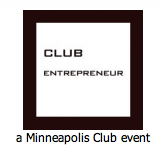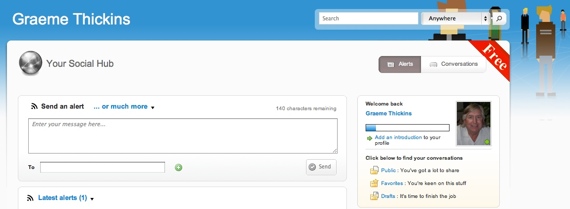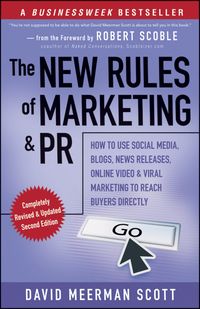Is it possible to design a radio app that delivers the ultimate radio experience, complete with visually stunning graphics and social media capabilities, too?  Minneapolis’ own Handcast Media Labs LLC thought so, set out to prove it, and just launched the result on the iTunes App Store a couple of days ago. It’s called Spark Radio (press release), and works on the iPhone and iPod Touch. It’s available for $5.99 at this link at the App Store.
Minneapolis’ own Handcast Media Labs LLC thought so, set out to prove it, and just launched the result on the iTunes App Store a couple of days ago. It’s called Spark Radio (press release), and works on the iPhone and iPod Touch. It’s available for $5.99 at this link at the App Store.
I grabbed it the day it came out and have used it multiple times since, in a variety of situations — at home, on a road trip, even in a foreign country (Iowa) — and I must say I’m impressed. Right now, I’m listening to a great station that’s all Grateful Dead all the time, which I discovered via the app. It’s called RadioIO Dead, and “Big Boss Man” has been my favorite track so far. I’m on wifi in my motel room at the moment, and the sound is perfect — and I’m not even using an external speaker. On the way down here to Des Moines, I used the app via my iPhone on AT&T’s 3G network (note: I was in the passenger seat!) to tune in multiple stations, including WSL in Chicago, and the sound was way better than any station I could tune in on the car radio.
Spark Radio not only gives you tons of station choices and social media features designed to make radio listening more interactive, but it also features visually stunning animations. Far out, huh? Its robust, visual radio tuner uses the guide from a company called RadioTime.com to give you access to more than 10,000 terrestrial and Internet-only radio stations worldwide. Handcast says it’s adding new stations to Spark Radio daily, and will support more than 30,000 stations by April. You can listen to precisely what you want to at any given time — music, talk radio, sports events, public radio, or special programming from around the world. Its elegant interface lets you search for stations or programs by keyword, location, or the station URL, and you can browse programming by genre or location. (I’m still looking for two of my fav genres: rockabilly and surf.) A GPS component lets you find local stations in any given city based on current GPS coordinates.
I took the opportunity to dial up the founder of Handcast Media Labs, Terry Anderson, whom I’d met in 2008, to ask if he’d be up for an interview. That follows.
Graeme: Terry, I know you’re no newcomer to interactive and Internet marketing here in Minnesota. Give us a synopsis of your background.
Terry Anderson: Well, I’ve been involved in technology for almost 30 years now. I founded e.Media group in 1995 and we were one of the early interactive agencies in the Twin Cities, with a lineup of really great national clients. That was incredibly fun. I sold that agency in 2004 (it's now known as Idea Park) and have been involved in entrepreneurial ventures since. I got energized by the iPhone platform in 2008 and have been working in that sphere since then.
Graeme: How did you come to start Tiny Wonder Studios, and then Handcast? And tell us about the rest of your team.
Terry Anderson: Tiny Wonder is a division of Popular Front, an incredible interactive agency here in the Twin Cities. I’m involved as a consultant and helped form the new entity and create Pixi, their first iPhone app. I’ve been close friends with Laurence Bricker of Popular Front since we were young. Laurence is a true visionary in the interactive world and it was great to collaborate with him once again. HandCast Media Labs is my own startup, specializing in iPhone applications. I needed a place to pursue my own ideas, so started HandCast in the spring of 2009. We’re trying to push the limits of technology and creativity. There are a number of people involved, but the nucleus includes Greg Sharp, a visionary and longtime partner of mine, and Jesse Hemmingway, who is simply the best developer I’ve ever worked with. It’s an incredible group and we’ve been collectively pushing the boundaries for a long time now.
Graeme: I grabbed that first app from Tiny Wonder, the Pixi drawing app (see screenshot), right when it came out. Refresh my memory — when did that hit the App Store? And how has it done since then? 
Terry Anderson: Pixi was developed as an experiment and hit the iTunes store about a year ago. (It’s available for $1.99 at this link on the App Store.) We wanted to learn the intricacies of iPhone development and start figuring out what it would take to successfully market an app on iTunes. It’s a beautiful and highly creative application. It continues to sell moderate amounts on the store, but we never really put enough marketing energy behind Pixi. We get comments all the time that Pixi is the best app on the store and we know we have a significant audience if we can reach them. Look for a Pixi re-launch in the upcoming months. We have some very exciting things planned. One thing we’ve learned is that iPhone apps need a formal marketing plan, just like any other consumer product. There are simply so many applications available on iTunes that you need to find a way to become visisble. We’re excited about the future of Pixi.
Graeme: Did you develop any other apps after Pixi, either for the iPhone or other mobile platforms?
Terry Anderson: Before we began work on Spark Radio, we began a prototype of what I’ll describe as a geo-spatial game. That project has been put on a back-burner for now. I believe if we can make it work, it could be a mega-hit. But the scope is very substantial and we decided to focus on titles we could get completed in a reasonable period of time. Stay tuned.
Graeme: So, let’s talk now about the Spark Radio app. What made you decide to do a radio app? What did you think you could bring to this category that others weren’t doing already? Aren’t there tons of streaming radio apps?
Terry Anderson: When we launched Pixi, we were overwhelmed with the number of people who asked if the Pixi animations could possibly interact with music from the iPhone or iPod. It turns out that Apple has made that impossible. We began looking at other ways to make that happen and came up with the idea of streaming radio, where we have control over the audio stream. We knew that including graphic visualizers would give us a point of difference from the competition. We also got very excited about the idea of global radio, and decided to include some social features to support that idea. I think it’s fascinating that someone in South Korea is listening to a hip-hop station out of Paris. We’re in love with that idea. The decision to do a radio app was fairly pragmatic. My research showed that this was a very lively niche within iTunes and that people were looking for quality. While there were a number of products out there already, we felt that nobody had really developed a robust product with an elegant user interface. We knew that if we made the experience more fun for listeners, we could succeed. We launched two days ago and are already #32 on the iTunes list of best sellers, so I think we called that one correctly. We’re very proud of the product and have some great enhancements coming.
Graeme: How long did take you to develop Spark? And do you have plans to do versions of it for any other platforms?
Terry Anderson: It took us eight months to develop Spark Radio. That was complicated by the fact that our lead developer broke his collarbone somewhere in the middle of the project! He took a bad fall on his bike one night and it was impossible to have someone take over his part of the project. So, say seven months if you eliminate the injury. That was a tense time, but it all turned out well. We have always planned to do an Android version of Spark Radio. We’re very excited about Android and hope to support it in parallel with iPhone. We have some concerns about the graphics performance on Android, but we’ll figure that out as we go.
Graeme: Being a longtime promotion guy, you have a pretty cool giveaway going on now for the Spark Radio app. Tell us about that.
Terry Anderson: I hate to call it a promotion. We’re simply giving away 500 iTunes gift certificates ($10) to friends as a celebration of our launch, so they can download Spark Radio for free. If your readers want to participate, they can email us their name & email address and we’ll send them the gift certificate. It’s a way for us to show appreciation for all the great friends who have supported us over the years. They can send their info to sparkgift (at) handcastmedia (dot) com.
[Blogger's note to the FTC: no freebie coupon here — I bought my own app!]
Graeme: So, Terry, what’s next for Tiny Wonder and Handcast? What growth plans do you have for your ventures?
Terry Anderson: As I mentioned, we have great plans for Pixi, and I wouldn’t be surprised to see it on the bestseller list by summer. The success of Spark Radio has been overwhelming, but we’ll keep working until we get to the top of our category. HandCast will be developing a new title soon and we’re also pitching some ideas that are too large for us to execute on our own. Given the success of Spark Radio, we’re being contacted for some very interesting contract work as well. It’s all good.
———–
Thanks, Terry. A company that develops apps “designed to entertain the senses” can’t be all bad. And I like how Handcast further describes its vision as “empowering users to explore their own creativity by meeting their entertainment-on-the go needs.”
You can learn more at the Handcast Media Labs web site, and you can follow Spark Radio on Twitter and on Facebook.
![Reblog this post [with Zemanta]](https://img.zemanta.com/reblog_e.png?x-id=766d2117-d338-4d16-8445-7806c3403c61)





![Reblog this post [with Zemanta]](https://img.zemanta.com/reblog_e.png?x-id=db80f9e6-6690-4cb9-94d5-696390c0d9b6)


![Reblog this post [with Zemanta]](https://img.zemanta.com/reblog_e.png?x-id=3dda3dd8-2d5e-4d26-bfc9-b6dc12ce89a8)


Recent Comments